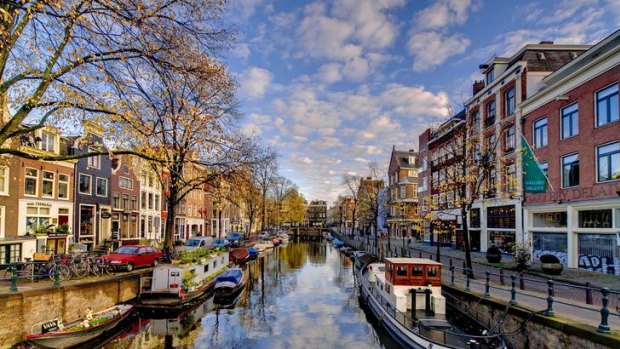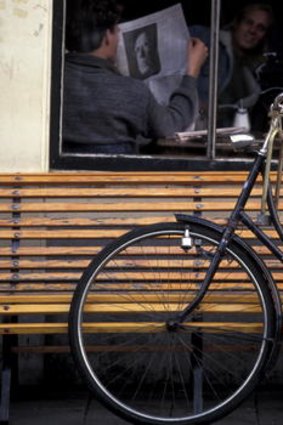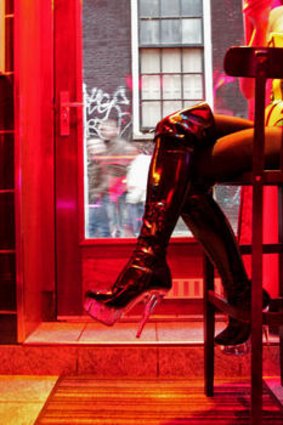
Canal, Amsterdam.Credit: Getty Images
It's hard to miss Amsterdam's red-light district and cannabis cafes but Terry Smyth aims to delve further into the famous Dutch city.
"THERE'S more to Amsterdam than whores and dope," says Piet van Winden as we sit savouring wine and stroopwafels in a grand room of the Het Grachtenhuis (The Canal House museum). It's the very room in which the US founding father John Adams convinced the good burghers of Amsterdam to bankroll the American War of Independence. As an Adams fan from way back, I'm suitably impressed.
An expert on Amsterdam's World Heritage-listed ring of canals and monumental buildings, van Winden is the director of the museum, a stately canal-side mansion of the 17-century Dutch Golden Age, when the Dutch trading empire made Amsterdam the richest city in Europe.
There is indeed much more to this beautiful, historic, liberal, vibrant city than hookers and hemp. And van Winden's wise words are ringing in my ears the next day while I'm window-shopping in the red-light district. I've come to De Wallen, known the world over for the women in the windows, because I consider it my duty to our readers to see firsthand what it is there's more to Amsterdam than. No, really.
The red-light district is, more precisely, a red- and blue-light district: red for women and, to avoid confusion, both red and blue for trannies - a result of complaints by patrons who didn't appreciate the opposite of being short-changed.
Famously, the prostitutes sit in window parlours and draw a curtain if they entice a client in to sample their charms. Some are drop-dead gorgeous, while others are presumably catering to a niche market. I tour the facility with, hopefully, a look on my face that says "Just browsing, thanks". Back home, when asked the inevitable question, I can now say I've been there and not done that.

On your bike ... cafe culture.Credit: Getty Images
The Dutch word for coffee is "koffie". So when you pass a "coffee shop" you know the English spelling indicates a shop licensed to sell small quantities of cannabis to adults over 18. However, there's no need to look for the signs - just follow your nose and you'll notice, too, that many of the mostly young patrons sitting staring into the middle distance in the morning are still there in the afternoon.
Ordering a brew, I discover that while Dutch "koffie" meets the strict standards of the world's biggest coffee snobs - namely Sydneysiders - Dutch "coffee" is merely a muddy excuse to call a dope den a cafe.
I ask the waiter (or is it dealer?) for something I would have smoked back in the '60s had it not been illegal. Nodding sagely, he says he has just the thing. It cost about €10 ($12), from memory.

The red light district lures.Credit: AFP
Does it do the trick? Well, at least it kills the taste of the coffee.
Later, strolling alongside canals and across bridges, I can't help noticing that many of the city's handsome old buildings are leaning outwards. Radically. Did I spend too long at the coffee shop? No, the alarming tilt is deliberate or the result of subsidence, depending on whom you ask.
Some say the facades were built leaning forwards on purpose so furniture unable to fit up the steep, narrow staircases could be hoisted to the upper floors. Others point out that Amsterdam, having been built on sandy soil below sea level, is settling at about two millimetres a year. Multiplied by three centuries, that's quite a tilt. It turns out both explanations are correct - some buildings were designed to lean; others are lopsided because they're founded on unstable soil. Whatever the cause, the effect is equally unnerving until you get used to walls that lean on you rather than the other way around.
While Amsterdam is eminently strollable, it's also one of the most bicycle-friendly cities in the world. For a population of about 770,000, there are more than 600,000 bicycles. With so many narrow streets and canals, bikes, not cars, are the best way to get about. Mind how you go, though - the canal bottoms are said to be one-third sand and two-thirds bicycles (25,000 end up in the canals each year).
Passing the much-photographed bike-parking ramp by Central Station, which holds about 7000 bikes, it seems to me the Dutch have something in common with penguins: the ability to find their own in a sea of sameness.
Because more than a quarter of the Netherlands is below sea level or barely above it, sea walls, dykes and dams were built throughout the centuries to prevent floods and reclaim land, with canals reaching inland from the North Sea. Amsterdam has hundreds of kilometres of canals and, though no longer the commercial arteries of the city, the canals are a relaxing way to see the sights. Many former trading barges - handsome timber craft that are as much an attraction as the canals themselves - are now tour boats and houseboats.
On a night canal tour in a charming old salon boat, I note that few of the houseboats and canal-side apartments have curtains in the windows. I'm told that in traditional Dutch Calvinist society, having no curtains meant you had nothing to hide; your propriety was on display for all to see. In today's famously broad-minded Dutch society, having no curtains means your nudity is often on display for all to see. Honestly, I didn't know where to look. At first.
On foot, by bike, boat or however you tour Amsterdam, there are two must-sees.
The Van Gogh Museum has the world's largest collection of the artist's works, including 200 paintings and many of his drawings and letters. See it on a starry night.
The Anne Frank House, with its secret annexe where Anne, her family and others hid from the Nazis during World War II, is an experience that would melt a heart of stone.
Getting out and about works up an appetite and diners in Amsterdam are spoilt for choice. My pick is traditional Dutch fare at Haesje Claes restaurant in the city centre. The candied duck leg with sauerkraut is tempting, as is the game stew, but I opt for fillet of hare, washed down with Zatte beer, an amber boutique brew that at 8 per cent alcohol should be enjoyed in moderation. Probably.
As you'd expect, Amsterdam offers a wide range of accommodation, from one- to five-star hotels, as well as apartments and houseboats. I hang my hat at two hotels in the city centre: the four-star Convent Hotel, a clever refit of a 13th-century nunnery, which features the Duke of Windsor, a bar in the style of the dining car on the Orient Express; and the five-star Sofitel Legend The Grand Amsterdam, a heritage-listed former royal residence and council chamber. Both hotels have comfortable, classically stylish rooms and excellent amenities.
Amsterdam's nightlife has won it a reputation as a party town. For bar-hoppers there are more than 1000 bars to hop to and from and for the youthfully insouciant there are live music venues to dance the night away in, as well as "edgy" back-street clubs touted as the places to go to watch the fashionistas at play.
But for me it's the plush velvet luxury of the Convent's Duke of Windsor bar - just me, the barman, one other guest who, from a certain angle, looks vaguely like Hercule Poirot, a quiet drink, a newspaper, old-world ambience and mixed nuts. Now that's what I call a Dutch treat.
The writer visited Amsterdam as a guest of Emirates and Accor hotels.
Trip notes
Getting there
Emirates operates more than 60 flights a week from Australia to Dubai, with daily connections to 29 European destinations, including Amsterdam, emirates.com
Staying there
The Convent Hotel MGallery, a canal-side boutique hotel, has 148 rooms from $146 a night and features the impressive Duke of Windsor bar, mgalleryhotels.com.
The historic Sofitel Legend The Grand Amsterdam, in the city centre, has 177 rooms from $240 a night, sofitel.com.
See + do
Amsterdam's tram system is fast and efficient but the best way to tour the city is on foot, by bicycle or by tour boat and salon boat on the canals. Must-sees are the Anne Frank House (cost is $11, book online to avoid the long queues, annefrank.org) and the Van Gogh Museum (cost is $17 at museum or online, vangoghmuseum.nl).
Sign up for the Traveller Deals newsletter
Get exclusive travel deals delivered straight to your inbox. Sign up now.